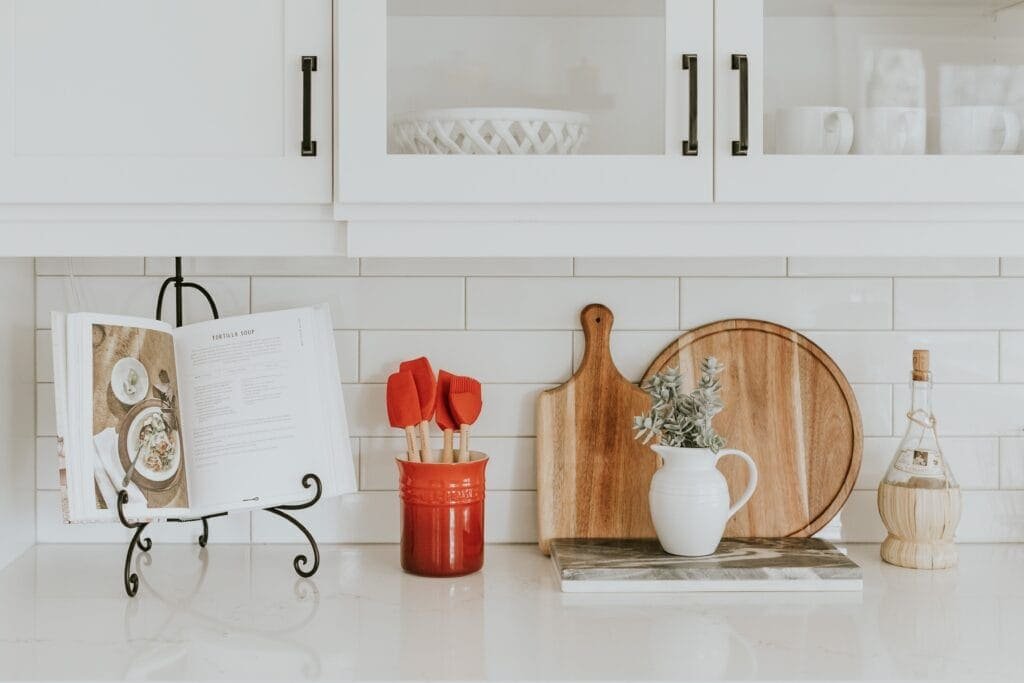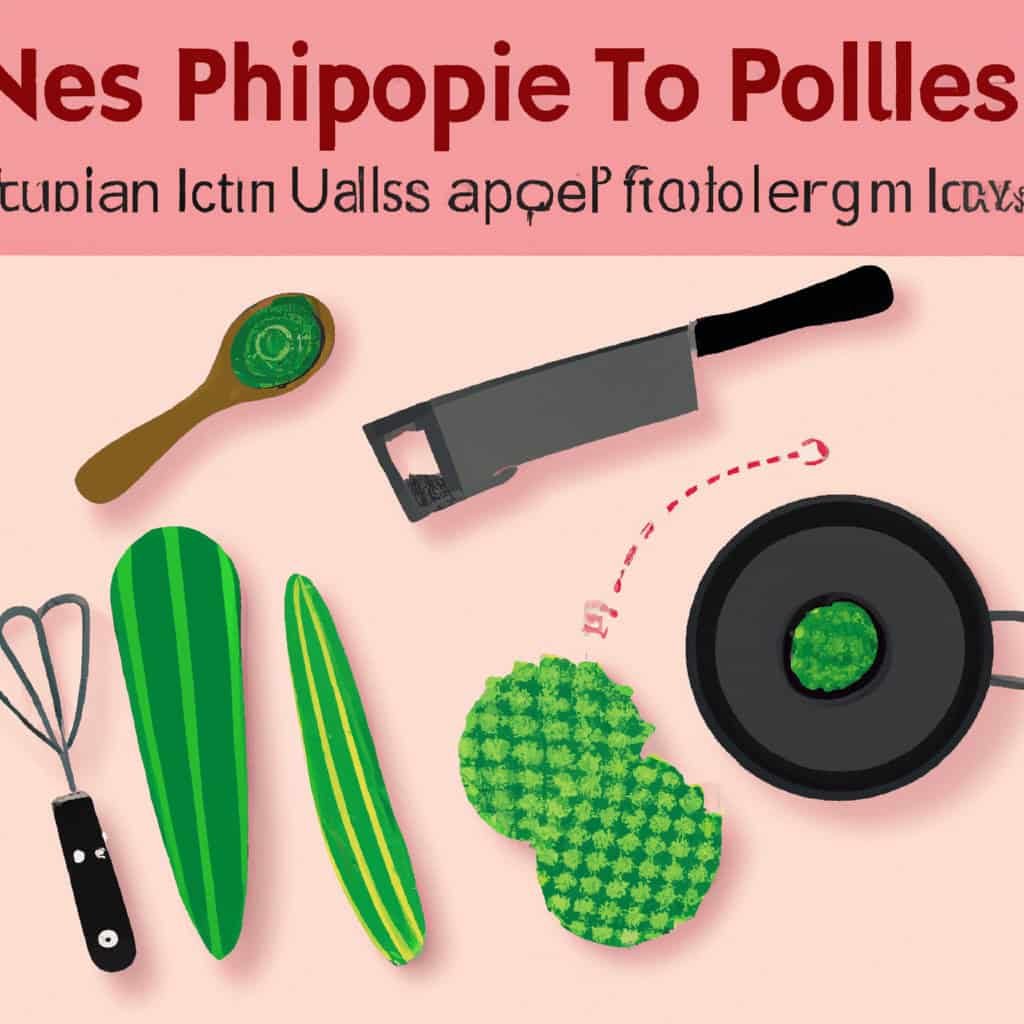If you’re looking to explore the culinary world of nopal, also known as prickly pear cactus, then you’ll want to ensure you have the right tools and equipment in your kitchen. From slicing and dicing to grilling and sautéing, cooking with nopal requires its own set of essentials. In this article, we’ll walk you through the must-have tools that will make your nopal cooking adventures a breeze. So whether you’re a beginner or a seasoned cook, get ready to equip your kitchen for some delicious nopal dishes!
Cutting and Preparing Nopal
When it comes to cutting and preparing nopal, having the right tools is crucial to ensure an easy and efficient process. One essential tool for this task is a chef’s knife. A good chef’s knife will allow you to cut through the tough exterior of the nopal pads with ease, making it easier to remove the spines and slice them into the desired shape and size.
In addition to a chef’s knife, a reliable cutting board is also essential. Look for a cutting board that is sturdy and large enough to accommodate the size of the nopal pads. This will provide you with a stable surface to work on and help prevent any accidents while cutting.
When handling nopal, it’s important to protect your hands from its spines. This is where a pair of tongs comes in handy. Use the tongs to hold the nopal pads securely while cutting or cleaning them. They will also come in handy when transferring the prepared nopal to a cooking surface or serving dish.
Lastly, a brush can be useful for removing any remaining spines or dirt from the nopal pads. Gently brush the pads with the bristles to ensure they are clean before cooking or further preparation. These tools will make the process of cutting and preparing nopal much easier and safer.
Cooking Nopal
Once the nopal pads are cut and prepared, it’s time to cook them to enhance their flavor and texture. There are various cooking methods you can choose from, depending on your preferences and the dish you are preparing.
One popular method is using a non-stick skillet. Heat the skillet over medium-high heat and add the prepared nopal pads. Cook them for a few minutes on each side until they are tender and slightly browned. This method is great for creating a delicious side dish or adding grilled nopal to tacos or salads.
Another cooking method is grilling. Preheat the grill to medium-high heat and place the prepared nopal pads directly on the grill grates. Cook them for a few minutes on each side until they are slightly charred and tender. Grilling imparts a smoky flavor to the nopal, making it a great option for creating flavorful dishes.
If you prefer a softer texture, boiling the nopal is a great option. Fill a pot with water and bring it to a boil. Add the prepared nopal pads and cook them for about 10-15 minutes until they are tender. Boiled nopal is perfect for adding to soups, stews, or even enjoyed on its own as a side dish.
These cooking methods will help you bring out the natural flavors of the nopal and provide you with versatile options for incorporating it into a wide variety of dishes.

Blending and Mashing Nopal
Blending and mashing nopal is a great way to create sauces, spreads, or dips with a smooth and creamy texture. To achieve this, you will need a blender. A high-speed blender works best for breaking down the fibrous texture of the nopal pads and creating a smooth puree.
Simply add the prepared nopal pads to the blender and blend on high until you reach the desired consistency. You can adjust the thickness of the puree by adding a little water or other liquids if needed. Blended nopal can be used as a base for salsas, dressings, or even as a spread for sandwiches and wraps.
If you prefer a chunkier texture, a mortar and pestle can be used to mash the nopal into a paste. This traditional method allows you to control the consistency and texture of the mashed nopal. Simply place the prepared nopal pads in the mortar and use the pestle to crush and mash them until you reach your desired consistency.
Blending and mashing nopal opens up a world of possibilities in terms of flavors and culinary creations. Experiment with different ingredients and seasonings to create unique and delicious dishes.
Measuring and Mixing
When it comes to measuring and mixing the ingredients for your nopal dishes, having the right tools will ensure accuracy and ease of preparation. One essential tool for this task is a set of measuring spoons. These spoons come in different sizes, allowing you to accurately measure small amounts of spices, herbs, or other ingredients.
A mixing bowl is also necessary for combining the ingredients together. Choose a bowl that is large enough to hold all the ingredients and has a stable base to prevent any spills or accidents while mixing. A bowl with a non-slip base or a grip is particularly useful to keep the bowl steady during the mixing process.
To blend the ingredients smoothly and evenly, a whisk is the ideal tool. Use the whisk to thoroughly combine the ingredients, ensuring that all the flavors are well-distributed. Whisks come in various sizes, so choose one that is appropriate for the quantity of ingredients you are working with.
A spatula is another handy tool for mixing and scraping down the sides of the bowl to incorporate any ingredients that may have stuck. It’s important to have a flexible and heat-resistant spatula that can withstand high temperatures without melting or warping.
With these tools, measuring and mixing the ingredients for your nopal dishes will be a breeze, ensuring consistent and delicious results every time.

Seasoning Nopal
Seasoning nopal is an essential step in bringing out its unique flavors and enhancing the taste of your dishes. There are various seasonings you can use to complement the natural taste of nopal and create a well-balanced dish.
Salt is a basic seasoning that helps bring out the flavors of the nopal. Sprinkle a pinch of salt on the cooked nopal to enhance its taste. Remember to taste as you go and adjust the amount of salt according to your preference.
A pepper grinder is a great tool to have for adding freshly ground pepper to your nopal dishes. The sharp blades of the grinder release the aromatic oils from the peppercorns, providing a burst of flavor. Grind some black pepper over the cooked nopal to give it a subtle kick.
Lime is another essential seasoning for nopal. Squeeze fresh lime juice over the cooked nopal to add a tangy and zesty flavor. The acidity of the lime juice balances out the earthy taste of the nopal, creating a refreshing and vibrant dish.
To add depth and complexity to your nopal dishes, experiment with different spices and herbs. Common spices that pair well with nopal include cumin, paprika, and chili powder. Add a pinch of these spices to create a flavorful and aromatic dish.
Fresh herbs like cilantro can also elevate the taste of nopal. Chop some fresh cilantro leaves and sprinkle them over the cooked nopal to add a burst of freshness and a hint of citrus. The herbaceous aroma of cilantro complements the earthiness of nopal beautifully.
By seasoning your nopal properly, you can create dishes that are bursting with flavor and sure to impress.
Storing Nopal
Proper storage is essential to maintain the freshness and quality of nopal. After preparing or cooking nopal, it’s important to store any leftovers or unused portions correctly to ensure they stay fresh and safe to eat.
Sealable containers are a great option for storing nopal. Choose containers that have a tight-fitting lid to keep moisture and air out, preventing the nopal from spoiling or drying out. Glass or plastic containers with airtight seals work well for storing nopal.
When storing freshly cut nopal, you can also use plastic wrap to cover the container or wrap the nopal tightly. This helps to retain moisture and protect the nopal from any cross-contamination in the refrigerator.
To maintain its freshness, store the nopal in the refrigerator. Place the sealed containers or wrapped nopal in the refrigerator’s main compartment away from any strong-smelling foods to prevent odor transfer.
When stored properly, nopal can stay fresh for up to several days, allowing you to enjoy its flavors and incorporate it into various dishes throughout the week.

Adding Flavors and Ingredients
While nopal is delicious on its own, adding flavors and ingredients can take it to another level. There are several ingredients that pair exceptionally well with nopal and can enhance the overall taste and texture of your dishes.
Onion is one such ingredient. The sweet and savory nature of onions complements the earthy taste of nopal and adds depth to the flavor profile. Sauté some diced onions before adding the nopal to create a flavorful base for your dishes.
Garlic is another fantastic addition to nopal dishes. The aromatic and pungent flavors of garlic infuse the nopal with a rich and savory taste. Finely mince some garlic cloves and sauté them with the nopal to create a delicious and aromatic dish.
Tomatoes are a classic pairing with nopal, adding a burst of freshness and tanginess. Dice some ripe tomatoes and cook them alongside the nopal for a tasty combination. The juicy texture of tomatoes balances the slightly firm texture of the nopal, creating a harmonious blend.
Cilantro, with its bright and citrusy flavors, complements the earthiness of nopal perfectly. Chop some fresh cilantro leaves and sprinkle them over your nopal dishes to add a refreshing element. The vibrant green color of cilantro also adds visual appeal to your culinary creations.
Lastly, avocado is a creamy and buttery addition to nopal dishes. The smooth and rich texture of avocado complements the slightly crunchy texture of nopal, creating a delightful contrast. Slice some ripe avocado and serve it alongside your nopal preparations for a delicious and satisfying combination.
By adding these flavors and ingredients, you can transform your nopal dishes into culinary masterpieces that are bound to impress.
Garnishing Nopal Dishes
Garnishing is the final touch that adds visual appeal and additional flavors to your nopal dishes. There are several garnishes that go particularly well with nopal and enhance the overall presentation and taste.
Cheese is a versatile and delicious garnish for nopal dishes. Sprinkle some crumbled queso fresco or shredded cheese on top of your cooked nopal to add a creamy and savory element. The slight saltiness of the cheese complements the nuanced flavors of nopal beautifully.
Sour cream is another fantastic garnish that adds a cool and creamy element to nopal dishes. Dollop some sour cream on your nopal preparations to create a delicious contrast in taste and texture. The velvety smoothness of the sour cream enhances the overall enjoyment of the dish.
Fresh cilantro leaves make for a beautiful and aromatic garnish for nopal dishes. Pluck some cilantro leaves and scatter them over the finished dish for a pop of vibrant green color and an extra burst of freshness. The herbaceous aroma of cilantro adds an appealing sensory element to your culinary creations.
Lime wedges are not only a garnish but also a functional addition to nopal dishes. Serve some lime wedges alongside your nopal preparations, allowing the diners to squeeze fresh lime juice over the dish to their liking. The tangy and zesty flavor of lime enhances the taste of nopal and adds a refreshing element.
Tortilla chips can be both a garnish and a complementary side to nopal dishes. Arrange some crispy tortilla chips around your nopal preparations to add a satisfying crunch and create a complete dining experience. The combination of nopal and tortilla chips is a winning duo that is sure to please.
By garnishing your nopal dishes, you can elevate their visual appeal and add an extra layer of flavor and texture, making them even more enticing to enjoy.

Serveware for Nopal
When it comes to serving nopal dishes, having the right serveware is essential to present your culinary creations in an appealing and practical manner. There are a few basic serveware items that are suitable for serving nopal dishes.
Plates are a staple serveware item that is suitable for presenting most nopal dishes. Choose plates that are large enough to accommodate the size of the dish without overcrowding. Opt for plates with a neutral color or pattern that won’t distract from the vibrant colors of the nopal.
Bowls are another serveware option that works well for soups, stews, or other nopal dishes with a liquid component. Select bowls with a wide rim and a deep base to hold the dish securely without any spills. Ceramic or glass bowls are ideal for showcasing the vibrant colors of the nopal.
Serving spoons are essential for transferring the nopal from the cooking vessel to the serving dish. Use a long-handled spoon with a wide bowl to scoop up the nopal easily and ensure an even distribution on the plates or bowls. Stainless steel serving spoons are durable and easy to clean, making them a practical choice.
Tongs are handy for serving grilled or sautéed nopal dishes that require individual portions. Use tongs with a sturdy grip and a scalloped edge for a secure hold on the nopal. This way, you can easily transfer the nopal from the cooking surface to the plates or bowls without any mess or accidents.
By choosing the appropriate serveware, you can showcase your nopal dishes elegantly and ensure a smooth dining experience for yourself and your guests.
Essential Nopal Cooking Techniques
Nopal is a versatile ingredient that can be cooked using different techniques, depending on the desired texture and flavor. Mastering these essential cooking techniques will allow you to create a wide variety of nopal dishes with delicious results.
Grilling is a cooking technique that imparts a smoky and charred flavor to the nopal. Preheat the grill to medium-high heat and place the prepared nopal pads directly on the grates. Cook them for a few minutes on each side until they are slightly charred and tender. Grilled nopal is perfect for adding to tacos, salads, or enjoying as a standalone side dish.
Boiling is a simple yet effective technique to achieve a soft and tender texture in nopal. Fill a pot with water and bring it to a boil. Add the prepared nopal pads and cook them for about 10-15 minutes until they are tender. Boiled nopal is excellent for incorporating into soups, stews, or other dishes that require a softer texture.
Sautéing is a quick and convenient cooking technique that adds a rich and savory flavor to nopal. Heat a skillet or sauté pan over medium-high heat and add a small amount of oil or butter. Add the prepared nopal to the pan and cook for a few minutes until it is slightly browned and tender. Sautéed nopal can be used in a wide range of dishes, from tacos to stir-fries.
Blending is a technique used to create smooth and creamy sauces or dips with nopal. Use a blender to puree the prepared nopal pads until you achieve a smooth consistency. You can adjust the thickness of the puree by adding water or other liquids. Blended nopal can be used as a base for salsas, dressings, or spreads.
By mastering these essential cooking techniques, you can unleash the full potential of nopal and create delicious dishes that highlight its unique qualities.
In conclusion, cooking with nopal can be a delightful culinary adventure. By having the essential tools and equipment, such as a chef’s knife, cutting board, blender, measuring spoons, and tongs, you can easily cut, prepare, blend, measure, and mix nopal. Seasoning nopal with salt, pepper, lime, spices, and herbs enhances its natural flavors. Storing nopal in sealable containers or wrapped in plastic wrap in the refrigerator maintains its freshness. Adding flavors and ingredients like onion, garlic, tomato, cilantro, and avocado takes nopal dishes to a whole new level. Garnishing nopal dishes with cheese, sour cream, cilantro leaves, lime wedges, and tortilla chips adds visual appeal and additional flavors. Serving nopal on plates, bowls, and using serving spoons and tongs presents the dishes elegantly. Mastering essential nopal cooking techniques like grilling, boiling, sautéing, and blending allows for a variety of delicious culinary creations. So, grab your tools and get ready to explore the wonderful world of cooking with nopal!


